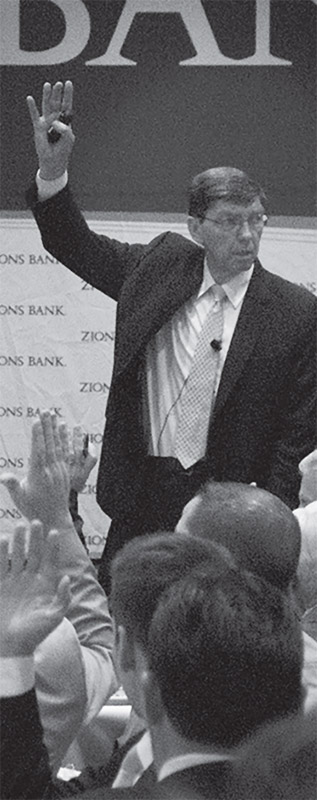Brice Wallace
The Enterprise
A renown author and educator who proffered the theory of “disruptive innovation” spent a while last week in Salt Lake City discussing McDonald’s milkshakes.
Clayton Christensen used that food product to demonstrate how many companies focus on their particular product or service rather than on the “job” that it can do for customers. Some of the tasks are simple and repetitive; others are complicated and time-consuming, said Christensen, a Utah native who currently is the Kim B. Clark Professor of Business Administration at the Harvard Business School. The “doing a job” concept is explored in Christensen’s latest book, Competing Against Luck.
“The reason why that’s important is, what causes us to buy products or services is that jobs arise in our lives that need to get done,” he said of the concept. “And we concluded that understanding the costumer is the wrong unit of analysis. It’s understanding the job that allows us to be successful over and over again.”
In the case of the milkshakes, some research determined that the typical buyer was making the purchase before 8:30 a.m., was alone and drove away with it with the shake being the only item ordered. Further research indicated that the buyers simply wanted something to keep them awake and engaged during a long, boring drive to work. That was the “job” that the milkshake was handling, and it was doing so better than its competitors: doughnuts, coffee, bananas, Snickers and bagels among them.
Such “jobs” are usually discovered and rarely created. For example, a product or service’s job may be to simply do what a person doesn’t want to do.
Many jobs are stable over time. Getting a thing to a place as soon as possible, with perfect certainty, at one time involved hiring a horseman and chariot, later became using telegraphs and ships, developed into using airplanes, and now involves DHL or the Internet. In each case, the job was stable but the technology to handle it changed, Christensen said.
“Those of us who are in the business of innovation sometimes think that our business is very unpredictable,” he said. “The answer is, that’s not true. The job to be done is very predictable over time, but the technology that is available to get the job done, that’s what creates trouble for us, but I think it causes us to think and frame things in the right way.”
No matter the job, it has functional, emotional and social dimensions and several levels. Companies looking to develop a product or service to be “hired” need to understand the job itself, the experience the purchase and use brings to the customer, and how to integrate it. Once those are achieved, the product or service can become a “purpose brand,” Christensen’s description of a brand that instantly pops into the customer’s mind when a certain job needs to be handled.
“Every product has to have these four elements to it, and if we do that, our experience is that we always are successful,” he said. “Whether it’s a product or a service, whether it’s in the not-for-profit or for-profit sector, if we thoughtfully address each of those four, we will be successful.”
Among purpose brands, he said, are IKEA, TurboTax, Disney, Mayo Clinic, OnStar, V8, Lunchables, Land Rover and Jack Bauer. He also listed the Chicago Cubs, whose job is not necessarily to win for the fans but to provide them an escape from work.
“If we realize, ‘Oh, I have this job to do. Holy cow, there’s a product that has a brand that does the job perfectly,’ we’re willing to pay a premium price for that product,” Christensen said.
But he cautioned that once a job is addressed, companies should resist the urge to add more. He cited as an example the Deseret News. Once only a provider of news, it branched into other activities — helping a person buy or sell a car or a home, find or fill a job, buy or sell stuff — but found itself outgunned by competitors. For example, Craig’s List “decimated” the Deseret News’ personal ads and Autotrade.com did the same to its car ads, he said.
“What’s happened in each case is, rather than having one thing do everything, there are competitors to the Deseret News that allows us to have these jobs done more effectively than does the Deseret News,” Christensen said. “I guess the point of this one is, an organization, in order to do a job well, has to do just one job in order to do it well. When we try to do everything, then we do nothing well.”
Another industry losing out to competitors is banking, he added. They have added many services over the years, “thinking that if your customers need one job [done], they need everything and you’ll be successful. But the very same thing has happened here: ‘Online everything’ has brought competitors to your business.”
Christensen said the “doing a job” concept came about when researching whether innovation is unpredictable. He noted that 80 percent of all new products fail after they reach the marketplace.
“Is failure an inherent part of success? Or are we failing so often in innovation because we at the business schools just haven’t taught it in the right way?” he asked. “Innovation is not inherently unpredictable. We can be successful far more often than we are.”
Christensen’s presentation was hosted by Zions Bank, the University of Utah David Eccles School of Business and Morgan Stanley.








